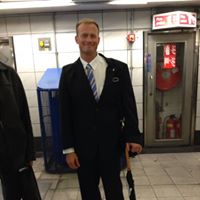Sam R Cowan
age ~82
from Stromsburg, NE
- Also known as:
-
- Sam Royce Cowan
- Sammy R Cowan
- Kathleen Cowan
- Phone and address:
-
309 10Th St, Stromsburg, NE 68666
(402)7642071
Sam Cowan Phones & Addresses
- 309 10Th St, Stromsburg, NE 68666 • (402)7642071
- Elmwood, NE
Isbn (Books And Publications)



Us Patents
-
Bandwidth Reduction By One Half
view source -
US Patent:20060198436, Sep 7, 2006
-
Filed:Jan 30, 2006
-
Appl. No.:11/341055
-
Inventors:Sam Cowan - Stromsburg NE, US
-
International Classification:H04B 1/66
-
US Classification:375240000
-
Abstract:A method for transmitting information on electromagnetic waves that requires less bandwidth than other common modes. The information is divided into two parts in the manner of the Weaver method of single sideband generation. These two parts each have one-half the bandwidth of the original information. The two parts are modulated on separate transmitters operating on the same frequency. The signals are kept separate through the use of circular polarized antennas. The received signals are demodulated and then recombined in a circuit identical to the one that divided them in the transmitter. The recombined signal is the same as the original information. The bandwidth used in the electromagnetic spectrum is one-half that of the information.
-
Sideband Suppression In Angle Modulated Signals
view source -
US Patent:20150117570, Apr 30, 2015
-
Filed:Oct 10, 2014
-
Appl. No.:14/511234
-
Inventors:- Stromsburg NE, US
Sam Cowan - Stromsburg NE, US -
International Classification:H04L 27/20
H04B 1/04 -
US Classification:375308
-
Abstract:In an angle modulated radio transmitter, the total power is the same when modulated or unmodulated. Angle modulation produces multiple sideband pairs. The power in the sidebands is derived from the carrier. When a complex modulating waveform is used, the power (and therefore the amplitude) of the carrier varies. A system and method is provided for dramatically minimizing, to nearly zero, the bandwidth needed to transmit digital information using sideband suppression of angle modulated signals. The systems described use various techniques to suppress sideband pairs, leaving the carrier signal. The amplitude variations of the carrier are used to convey information. In some examples, techniques are used to filter and/or phase out one or more sideband pairs, leaving the carrier signal.
Resumes

Owner
view sourceIndustry:
Transportation/Trucking/Railroad
Work:
Nation Track
Owner
Owner
Skills:
New Business Development
Customer Service
Team Building
Strategic Planning
Public Speaking
Customer Service
Team Building
Strategic Planning
Public Speaking

Sam Cowan
view sourceYoutube
Flickr
Googleplus

Sam Cowan
Education:
Burke Mountain Academy

Sam Cowan

Sam Cowan

Sam Cowan

Sam Cowan

Sam Cowan

Sam Cowan

Sam Cowan
Myspace

sam cowan
view source
Samantha Cowan
view source
Sam Cowan
view source
Sam Cowan
view source
Sam Cowan
view source
Sam Cowan
view source
Sam Cowan
view source
Sam Cowan
view source
Sam Cowan
view sourceClassmates

Sam Cowan
view sourceSchools:
Garden Spot High School New Holland PA 1982-1986

Cawood High School, Harla...
view sourceGraduates:
Kathy Sergent (1972-1976),
Sam Cowan (1989-1993),
Marion Greer (1975-1979)
Sam Cowan (1989-1993),
Marion Greer (1975-1979)

Northern Arizona Universi...
view sourceGraduates:
Sam Cowan (1968-1970),
Bill Mikulka (1986-1988),
Stephanie Webb (1986-1990),
Terrance Petty (1997-1999)
Bill Mikulka (1986-1988),
Stephanie Webb (1986-1990),
Terrance Petty (1997-1999)

New Madrid Central High S...
view sourceGraduates:
Jasmin Patel (1997-2001),
Samantha Cowan (1982-1986),
Bonnie Cantrell (1958-1962)
Samantha Cowan (1982-1986),
Bonnie Cantrell (1958-1962)

Oak Hill Elementary Schoo...
view sourceGraduates:
Samantha Cowan (1987-1988),
Elton Stokes (1967-1971),
Jackie Dillon (1964-1968),
Jennifer Squyres (1992-1996)
Elton Stokes (1967-1971),
Jackie Dillon (1964-1968),
Jennifer Squyres (1992-1996)

Sundre High School, Sundr...
view sourceGraduates:
Murray Scott (1989-1993),
Stuart Gordon (1960-1964),
Sherri Pearson (1983-1987),
Samantha Cowan (2000-2004),
Travis Stringer (1987-1991)
Stuart Gordon (1960-1964),
Sherri Pearson (1983-1987),
Samantha Cowan (2000-2004),
Travis Stringer (1987-1991)

Harrisburg High School, H...
view sourceGraduates:
Samantha Cowan (1996-2000),
Jody Larkin (1962-1966),
Lewis Karstetter (1979-1983),
Sylvia Nguyen (2000-2004)
Jody Larkin (1962-1966),
Lewis Karstetter (1979-1983),
Sylvia Nguyen (2000-2004)
Get Report for Sam R Cowan from Stromsburg, NE, age ~82















